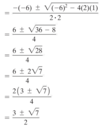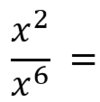Chapter 1 - 4: Calculus PreReqs Flashcards
Calculus PreReqs (81 cards)
solving quadratic equations: completing the square
3x² = 24x + 27
- put the variables on one side and the constant in the other: 3x² - 24x = 27
- divides both sides by coefficient of x²: x² - 8x = 9
- divide coefficient of x by 2 and square it, then add to both sides: x² - 8x + 16 = 9 + 16
- factor left side (factor always has same # from prior step): (x-4)(x-4) = 25 → (x-4)² = 25
- use square root property: x-4 = √25 → x-4 = ±5
- solve: x-4 = ±5 → x = 9 or -1

- The quantity b2 - 4ac, which appears under the radical sign in the quadratic formula
- determines the number and type of solutions
- b2 - 4ac > 0: Two unequal real solutions
- b2 - 4ac = 0: One solution (a repeated solution) that is a real number
- b2 - 4ac < 0: No real solutions
solving quadratic equations: quadratic formula
2x² - 6x + 1 = 12


solving quadratic equations: factoring
2x² - 5x = 12
- bring all terms to one side: 2x² - 5x - 12 = 0
- factor: (2x + 3)(x -4) = 0
- set each factor to 0 and solve: 2x + 3 = 0 → 2x = -3 → x = -3/2
- set each factor to 0 and solve: x - 4 = 0 → x = 4
- two solutions: -3/2, 4
differences of two cubes
64x³ - 125
- express each term as the cube of a monomial: 64x³ + 125 = 4x³ - 5³
- convert 4x³ - 5³ to (a³ - b³) = (a - b)(a² + ab + b²)
- (4x - 5)(4x² - 4x5 + 5²) → (4x - 5)(4x² - 20x + 25)
factoring sum of cubes
x³ + 8
- express each term as the cube of a monomial: x³ + 8 = x³ + 2³
- convert x³ + 2³ to (a³ + b³) = (a + b)(a² - ab + b²)
- (x + 2)(x² - x2 + 2²) → (x + 2)(x² - 2x + 4)
quadratic equation
- any second degree (highest power of x is 2) polynomial equation
- 2x² + 5x = 12
x² + bx + c
- when c is positive, find 2 numbers with …
- when c is negative, find 2 numbers with …
- the same sign as the middle term: x² - 5x + 6 = (x - 3)(x - 2)
- opposite signs whose sum is the coefficient of the middle term: x + 3x - 18 = (x + 6)(x - 3)
factoring trinomials steps
x² + 6x + 8
- find the first terms whose product is x²: (x, inside) (x, outside)
- find 2 last terms whose product is 8: 8, 1 or 4, 2 or -8, -1 or -4, -2
- select the terms whose outside product and inside product is 6x: 4, 2
- answer: (x, 4) (x, 2) (outside 2 ⋅ x + inside 4 ⋅ x = 6x)
- x² + 6x + 8
factoring by grouping
x³ + 4x² + 3x + 12
- group terms w/common factor: (x³ + 4x²) + (3x + 12)
- take out GCF: x²(x + 4) + 3(x + 4)
- take out GCF: (x + 4)(x² + 3)
factoring the greatest common factor
x²(x + 3) + 5(x + 3)
- if you are adding, the answer is multiplication
- GCF is (x + 3), so pull it out
- (x + 3)(x² + 5)
factoring the greatest common factor
18x³ + 27x²
- 9 and x² are the greatest integer and expression that divides in 18 & 27 and x² & x³
- 9x²(2x) + 9x²(3)
- 9x²(2x + 3)
what is the degree of the following polynomial:
4x⁵ - 6x³ + x² - 5x + 2
5
degree of a polynomial
the polynomial’s highest power of x
polynomial
- all terms have a variable raised to a positive integral power (no fraction or negative powers)
- just terms with a coefficient
- no logs, sines or cosines allowed
- ex: 4x⁵ - 6x³ + x² - 5x + 2
difference of cubes
(a³ - b³) = (a - b)(a² + ab + b²)
sum of cubes
(a³ + b³) = (a + b)(a² - ab + b²)
a difference of squares (a² - b²) _____ be factored, but a sum of squares (a² + b²) _____
- can
- can’t
factor the following
(3x²)² - (5)²
(3x² - 5)(3x² + 5)
rewrite the following to show a difference of squares (a² - b²)
9x⁴ - 25
(3x²)² - (5)²
LogcC =
1
Logc1 =
0
rewrite log₃81 = x
3ˣ = 81
logarithms
2³=8 as log is …
- log₂8 = 3
- log base 2 of 8 = 3


























